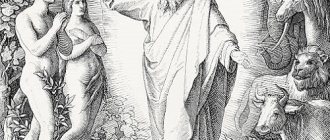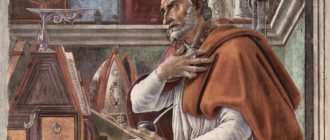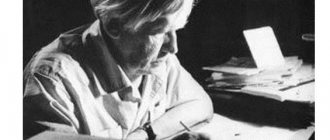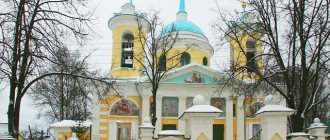In recent years, interest in the Old Believers . Many both secular and ecclesiastical authors publish materials devoted to the spiritual and cultural heritage, history and modern day of the Old Believers. However, the phenomenon of the Old Believers itself, its philosophy, worldview and features of terminology are still poorly studied. about the semantic meaning of the term “ Old Believers ” in the article “ What are Old Believers? "
Dissenters or Old Believers?
Old Believers itself arose forcedly. The fact is that the Synodal Church, its missionaries and theologians called the supporters of pre-schism, pre-Nikon Orthodoxy nothing more than schismatics and heretics. This was done because the ancient Russian Old Believer church traditions, which existed in Rus' for almost 700 years, were recognized as non-Orthodox, schismatic and heretical at the New Believer councils of 1656, 1666–1667.
Sergius of Radonezh In fact, such a great Russian ascetic as Sergius of Radonezh was recognized as non-Orthodox, which caused an obvious deep
protest among believers .
The Synodal Church took this position as the main one and used it, explaining that supporters of all Old Believer agreements without exception fell away from the “true” Church because of their firm reluctance to accept church reform, which Patriarch Nikon and continued to one degree or another his followers, including Emperor Peter I.
On this basis, everyone who did not accept the reforms was called schismatics , shifting onto them the responsibility for the schism of the Russian Church, for the alleged separation from Orthodoxy. Until the beginning of the 20th century, in all polemical literature published by the dominant church, Christians professing pre-schism church traditions were called “schismatics,” and the very spiritual movement of the Russian people in defense of paternal church customs was called “schism.”
This and other even more offensive terms were used not only to expose or humiliate the Old Believers, but also to justify persecution and mass repressions against supporters of ancient Russian church piety. In the book “ Spiritual Sling ,” published with the blessing of the New Believer Synod, it was said:
“The schismatics are not the sons of the church, but sheer heedless ones. They are worthy of being handed over to the punishment of the city court... worthy of all punishment and wounds. And if there is no healing, there will be death .
Pomeranians (Vygovtsy)
The history of the Vygovsky community begins at the end of the 17th century, but in the second half of the 18th century there was a flourishing of the theological, polemical and economic activity of the Bespopovites of Pomorie (north of the Arkhangelsk province), and in the 1730s. A real ideological revolution took place in Russian society as a result of the publication and dissemination of “Pomeranian Answers” (1723) by Andrei and Semyon Denisov . “Pomeranian Answers” completely refuted all the fakes fabricated to denigrate the Old Believers from historical, grammatical, lexical, theological and paleographic points of view (and this was one of the first works of a paleographic nature in the world). Also, “Pomeranian Answers” contained the latest achievements of linguistics and philosophical methodology. The Denisov brothers were the founders of a new type of worldview - their worldview methodology departed from the traditional Old Believer polemics and apologetics, they not only argued with the Synodal Church, but also wrote a lot on purely practical spiritual topics: about the place of the individual in the Church, about the promotion of science to religious faith, about the importance of philosophy (“philosophy”) in the development of spirituality. The Denisovs were involved in almost all European sciences, even showing interest in neo-alchemy, which was fashionable in Europe at that time. In “Pomeranian Answers” Andrei Denisov “showed himself <...> not only as a historian, paleographer and liturgist with incredibly extensive and detailed knowledge, but also as a thinker with a deep and coherent system of views on the fundamental problems of the philosophy of church history” [10, 161]. The enormous significance of the “Pomeranian Answers” was the refutation of all attacks against ancient piety that existed at that time. The Denisovs proved by analyzing documents that the notorious “Act of Martin the Heretic” was a fake, fabricated to fight the defenders of the old faith in the 18th century, that pre-schism Russian Orthodoxy did not contain any deviations from the apostolic traditions.
The Vygovites scrupulously collected everything related to Old Russian and early Christian culture: books, icons, documents, liturgical utensils - and used it to create an “island of faith” in Pomerania, and this gave them extraordinary influence throughout the Old Believer world. Thus, by the end of the 18th century, they compiled (or rather, resurrected) the canon of ancient Orthodox singing “Poems Poemed”, used to this day by the Fedoseevites and the Pomeranians themselves.
The 18th century was the heyday of the Vygoleksinskaya desert. Pavel Milyukov wrote : “Denisov [Andrey. - K.M.] established business relations with various parts of the Old Believer world. He thus provided the first example of a broad commercial and industrial union on the basis of unconditional mutual trust and strict moral discipline - a model that was so successfully imitated by the schism of the late 18th and first half of the 19th centuries” [6, 81]. The Vygovites created the first industrial infrastructure of a new type in the industrial world of Russia, into which other agreements were drawn in, despite religious and ideological differences. In the words of ethnographer Irina Kremleva, “when in the 18th century. The Danilovsky Pomeranian monastery suffered from a fire, its community received help from the Filippovites” [4, 711].
Changing attitudes towards the term “Old Believers” in society
However, by the end of the 19th century, the situation in society and the Russian Empire began to change. The government began to pay great attention to the needs and demands of the Old Orthodox Christians; a certain generalizing term was needed for civilized dialogue, regulations and legislation. For this reason, the terms “ Old Believers ” and “Old Believers” are becoming increasingly widespread. At the same time, Old Believers of different consents mutually denied each other’s Orthodoxy and, strictly speaking, for them the term “Old Believers” united, on a secondary ritual basis, religious communities deprived of church-religious unity. For the Old Believers, the internal inconsistency of this term consisted in the fact that, using it, they united in one concept the truly Orthodox Church (i.e., their own Old Believer consent) with heretics (i.e., Old Believers of other consents).
Nevertheless, the Old Believers at the beginning of the 20th century positively perceived that in the official press the terms “schismatics” and “schismatic” began to be gradually replaced by “Old Believers” and “Old Believer.” The new terminology did not have a negative connotation, and therefore the Old Believer consents began to actively use it in the social and public sphere. The word " Old Believers " is accepted not only by believers. Secular and Old Believer publicists and writers, public and government figures are increasingly using it in literature and official documents. At the same time, conservative representatives of the Synodal Church in pre-revolutionary times continue to insist that the term “Old Believers” is incorrect.
“Recognizing the existence of the “ Old Believers ,” they said, “we will have to admit the presence of the “ New Believers ,” that is, admit that the official church uses not ancient, but newly invented rites and rituals.”
According to the New Believer missionaries, such self-exposure could not be allowed. And yet, over time, the words “Old Believers” and “Old Believers” became more and more firmly rooted in literature and in everyday speech, displacing the term “schismatics” from the colloquial use of the overwhelming majority of supporters of “official” Orthodoxy.
Settlement and social composition of Old Believers
Having been thrown out by the authorities from all spheres of influence on society in the 17th century: from culture, politics, public administration, the Old Believers began to hide in hard-to-reach places: in the north (Pomerania), in the Siberian taiga and in the Far East, which was then still uninhabited. The worldview that forever united them with Russia did not allow them to carry out mass emigration immediately at the time of the Schism, and even Avvakum had strong hopes that “the king would be forgiven” [2, 231]. At the end of the 17th century, Old Believers emigrated to Lithuania, Turkey, and the states of the “northern Habsburgs”. They did not lead a nomadic lifestyle - they built permanent settlements, but very often they could take off on a new journey, escaping from the tsarist army that was pursuing them.
Social composition. Old Believers until the second half of the 19th century. carefully avoided censuses, so it is very difficult to establish their number and class. Observers also became perplexed, because in the Old Believer settlements everyone dressed without class signs and did not show honor to anyone except the priests. But from the writing of the Old Believers themselves, we can conclude that in the 17th century. among the Old Orthodox Christians, peasants and artisans predominated [8, 74], there were also representatives of the aristocracy (the most striking examples are the nun Theodora and Evdokia Urusova, the Denisov brothers); in the 18th century the situation could not change radically; most likely, the situation remained the same.
On the other hand, the stratification approach of Pitirim Sorokin dissociates itself from the professional approach, concentrating attention on the places of residence of the Old Believers, thus dividing them into two abstract categories: urban and “traditional” (rural, rural). Urban Old Believers, mainly merchants and artisans (individuals, artels and manufacturers), were interested in strengthening their positions. Until the second half of the 18th century, they did not try to strengthen them by maintaining contacts with the state church, but tried to obtain the right to build prayer houses or churches. They established connections with commercial and industrial circles and collected community capital, which many attribute to the germs of proto-capitalism [3, 6]. “Traditional” Old Believers lived in remote villages; all the customs and peculiarities of life of both post-schism Russia and their fellow entrepreneurs were alien to them. Such Old Believers led a self-sufficient lifestyle, shunning the public life of Russia, and it was in such circles that anarchist movements and radical trends of Old Believers, such as the Netovites, began to appear.
Settlement. Basically, two main aspects of the settlement of the Old Believers are revealed: Russia and emigrants abroad. In Russia, this is, firstly, Pomorie - the north of the Arkhangelsk province, where the Vygovskaya hermitage arose - one of the main engines of not only the Old Believer, but also the all-Russian economy as a whole [3, 6] [6, 81]. Old Believers also settled in the vicinity of the cities of Kostroma, Vladimir, Veliky Novgorod and Nizhny Novgorod [12, 20] - the European part of Russia, as well as in the forests of Siberia and the Far East and in the vicinity of the cities of Kazan, Tyumen, Tobolsk, Irkutsk [9, 57].
From the end of the 17th century, a fairly lively Old Believer emigration brought large masses of believers to Austria, Prussia, and Turkey. In Turkey, the settlement of Stepan Razin’s comrade-in-arms, Ataman Ignat Nekrasov, was known, which was distinguished by extreme intolerance towards non-Christian foundations, but at the same time, Nekrasov’s people believed that Turkey was more suitable for realizing the Christian faith on a personal level than Russia.
There were also quite numerous settlements of Old Believers in the Polish-Lithuanian Commonwealth. There, priestlessness played a huge role, and in relatively free conditions it managed to organically merge into the economic infrastructure of the national outskirts [1].
The worldview of the Old Believers was in connection with their resettlement. To better understand the currents of Old Believer thought, it is important to know the areas of settlement of different groups of Old Believers. Pavel Ryndzyunsky writes: “The main areas of distribution of the Old Believers in the first half of the 18th century. there were Zaonezhye, Middle Volga region, forests of Belarus and Northern Ukraine, as well as the Don steppes. In the northern zone, priestlessness prevailed, and in the center and in the south, priesthood prevailed” [11, 268]. Perhaps it was precisely the difficulties in the migration of the Bespopovites associated with the northern nature that were the reason that the main emigrants were the Popovtsy (more precisely, the Beglopopovtsy), and the Bespopovtsy, isolated in the North, followed the path of dogmatic and internal political reforms. In total, according to the 1753 census, there were 36,842 “schismatics” in the country [11, 302].
Old Believer teachers, synodal theologians and secular scholars about the term “Old Believers”
Reflecting on the concept of “Old Believers,” writers, theologians and publicists gave different assessments. Until now, the authors cannot come to a common opinion.
It is no coincidence that even in the popular book, the dictionary “Old Believers. Persons, objects, events and symbols” (M., 1996), published by the publishing house of the Russian Orthodox Old Believer Church, there is no separate article “Old Believers” that would explain the essence of this phenomenon in Russian history. The only thing here is that it is only noted that this is “a complex phenomenon that unites under one name both the true Church of Christ and the darkness of error.”
The perception of the term “Old Believers” is noticeably complicated by the presence among Old Believers of divisions into “concords” (Old Believer churches), which are divided into supporters of a hierarchical structure with Old Believer priests and bishops (hence the name: priests - Russian Orthodox Old Believer Church , Russian Old Orthodox Church ) and into those who do not accept priests and bishops - non-priests ( Ancient Orthodox Pomeranian Church , Chapel Concord , runners (wanderer consent), Fedoseyevskoe consent).
Patriarch Nikon: influence on the Tsar
The church schism in Russia is inseparable from the name of Patriarch Nikon. In the world he is known as Nikita Minin. The years of his life are 1605-1681. He became a clergyman at the behest of his parents and in this field reached great heights. In 1643, he received a significant church position, becoming abbot of the Kozheozersky monastery, located in the Arkhangelsk province.
In 1646, Nikon arrived in Moscow on monastery business, and he was introduced to the then young Tsar Alexei Mikhailovich. The latter was 17 years old at the time. The young sovereign liked the abbot so much that he decided to leave him at court and appointed him to the post of archimandrite in the Moscow Novospassky Monastery. Subsequently, thanks to the royal favor, Nikon became the Metropolitan of Novgorod.
In 1651, the tsar demanded the return of Nikon to the capital, and since then he began to influence Alexei Mikhailovich with even greater force. Enjoying the full trust of the ruler, the clergyman took an active part in solving state affairs.
The pinnacle of Nikon's career was his accession to the patriarchal throne. This happened after the death of Patriarch Joseph in 1652. From that moment on, preparations for the long-overdue church reform began.
Old Believers - bearers of the old faith
Some Old Believer authors believe that it is not only the difference in rituals that separates the Old Believers from the New Believers and other faiths. There are, for example, some dogmatic differences in relation to church sacraments, deep cultural differences in relation to church singing, icon painting, church-canonical differences in church administration, holding councils, and in relation to church rules. Such authors argue that the Old Believers contain not only old rituals, but also the Old Faith .
Consequently, such authors argue, it is more convenient and correct from the point of view of common sense to use the term “ Old Belief ,” which tacitly implies everything that is the only true one for those who accepted pre-schism Orthodoxy. It is noteworthy that initially the term “Old Belief” was actively used by supporters of priestless Old Believer agreements. Over time, it took root in other agreements.
Today, representatives of New Believers churches very rarely call Old Believers schismatics; the term “Old Believers” has taken root both in official documents and church journalism. However, New Believer authors insist that the meaning of the Old Believers lies in the exclusive adherence to the old rituals. Unlike pre-revolutionary synodal authors, current theologians of the Russian Orthodox Church and other New Believer churches do not see any danger in using the terms “Old Believers” and “New Believers.” In their opinion, the age or truth of the origin of a particular ritual does not matter.
The Council of the Russian Orthodox Church in 1971 recognized the old and new rites as absolutely equal in rights, equal in honor and equally saving. Thus, in the Russian Orthodox Church the form of ritual is now given secondary importance. At the same time, New Believer authors continue to instruct that the Old Believers, the Old Believers, are part of the believers who separated from the Russian Orthodox Church, and therefore from all of Orthodoxy, after the reforms of Patriarch Nikon.
Reasons for the reform
Before considering the church schism of the 17th century, it is worth examining the reasons for the reform. Discussions about the need for reform of church life began in the 1640s.
Then a group called the “Circle of Devotees of Piety” was created in the capital. The members of the circle were representatives of the clergy. They advocated that church texts and rules of worship be unified.
But at the same time, there was no unity on the issue of choosing a sample according to which changes needed to be made. Some offered ancient Russian church books as a standard, while others suggested Greek ones.
Ultimately, victory was won by those who advocated for bringing church rites and books into conformity with the canons of Byzantium. There are several reasons for this choice.











